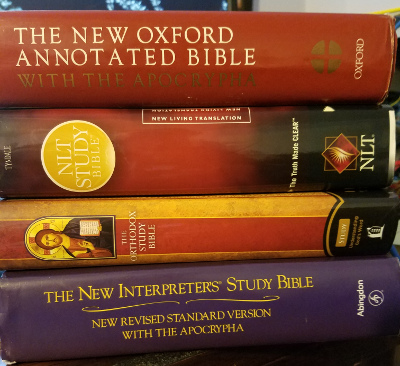Review: NIV Cultural Backgrounds Study Bible – Hebrews
Introduction
#contextchangeseverything – yes, it does. But how?
With the vast array of Bible study materials that are available in the English language comes a problem. How does one choose what materials are worth my time, shelf space (or HD space!), or money? If you search my blog for posts about study Bibles, you’ll find that I have a love-hate relationship with them, and it tends to be mostly hate. Nonetheless, I own—and use—a variety of study Bibles, and you’ll even see some positive reviews.
The reason for the hate side of the equation is that far too many people purchase a study Bible that’s recommended by someone they trust, or even written by someone they trust, not to mention randomly selected from a bookstore shelf and then accept what the notes say because they are written by biblical scholars after all. I recall being accosted by a church member some years ago who asked me about the notes on a particular text. I can’t even recall which text it was. Her problem was that she couldn’t figure out how the meaning presented in the note could be extracted from the text itself. I strongly recommend asking just such a question! I asked her if she’d considered the possibility that the note could be wrong. That was a revelation for her.
What I recommend is that a reader make sure to get study Bibles that are written from different perspectives and use them as an aid, not as a source of the answers. To some extent one should study the Bible text first, and then the notes, but sometimes one can read background material first. A study Bible that provides notes that tell you directly what the passage means can be quite convenient, but also quite misleading.
But one of the key problems for Bible students in the 21st century western world is the extent to which our culture is different from that of the world of the Bible. Very frequently what seems quite plain to us is not at all what the Bible writer is trying to say because we simply don’t share enough of those norms. I have come to believe that I have benefitted more by coming to understand human culture and language over the last 30 or so years than I have by learning the biblical languages. I do not mean to underestimate the value of learning Greek and Hebrew, but if my language learning had not been enhanced by the study of linguistics, history, sociology, and anthropology, it would have been of little value.
Pastors frequently proclaim that “the Greek word ____ means” or “the Hebrew word ____ means” and then build their exegesis on what is essentially simply another gloss. This makes people believe they have been enlightened by the ancient languages, when they have actually simply transferred their 21st century attitudes and presuppositions to a set of sounds they are told is Greek or Hebrew. Understanding a language means to some extent understanding a culture. Similarly understanding a text means understanding something about the person or persons who wrote it and the audience for which it was intended.
This is the key element that I believe a study Bible can provide. Certainly cross-references and historical connections are important, but letting the reader know how people in that time and place lived and thought is much more important.
NIV Cultural Backgrounds Study Bible

(Note: I am basing my notes on the Olive Tree Bible software edition provided to me free of charge as I did not receive my print edition. I will not make comments on the layout or usability of the print edition.)
Thus I come to the NIV Cultural Backgrounds Study Bible. They use the provocative (and obviously true) URL contextchangeseverything.com. I should note here that there are many types of context. There is a literary context, historical context, linguistic context, and (among others) cultural context. We usually think of context in a fairly narrow linguistic sense. A word study might be done by finding a variety of sentences that use a particular word. We know that when Jesus says, “Go and do likewise” we need to look at the context of what has been commanded. We can’t grab some other activity and make that the command of Jesus instead.
Study Bibles generally examine a range of these ideas as well as proposing interpretations for difficult passages, often without providing enough information so that the reader can follow the logic. The final reader is left with the simple logic that the skilled scholar who wrote the study notes concluded X, so X must be correct, an assumption that will be severely shaken in many cases if one compares other Bibles written by skilled scholars.
The Cultural Backgrounds Study Bible aims to help you understand the Bible writers, their audience, and their times. In the notes you will find direct connections between ancient culture(s) and the text itself. Rather than just being told that a certain phrase means a certain thing, you will be given the reason why one might come to that conclusion. This is no guarantee that every interpretation is correct; that would be expecting the impossible. (Which perfect one of us would make the determination in any case?) What it does mean is that for most explanations in the notes in this Bible you can follow the logic path. If you want to, you can do deeper research, and the notes are specific enough that you’ll be able to do your search, Bible dictionary reference, or deeper study in a commentary or at a good library.
Since I’m not reviewing the Bible overall, but rather looking in particular at one book, I won’t spend more time on an overview. Let me simply say that I’m delighted with the intent, and quite impressed with the implementation. There are obviously limitations. This is a study Bible, not a multi-volume commentary or an encyclopedia. It would be easy to complain about what’s not there. In my review of the book of Hebrews, I believe that the editorial choices made were quite good. I would doubtless have chosen differently in some cases, as would just about anyone, but that’s only to be expected.
On to Hebrews
To study Hebrews most effectively using this Bible, start first with the introduction to the Old Testament. Why? Because Hebrews displays an interesting interplay between the text of Hebrew Scripture, seen generally through the LXX translation, and then interpreted in a particularly New Testament light. The details of how these elements interact require some discussion, and that’s why you study and compare, but you need to understand the sources. The introduction discusses 12 issues in which we will see the world differently, and I think all of these issues will impact your reading of Hebrews.
While reading the text of Hebrews you can use the links (if you’re using Bible software) or follow the references to Old Testament passages. You cannot impose your own exegesis of passages of Hebrew Scripture on Hebrews, but it is important to know not just the text that is quoted, but also its literary context that might be brought to the audience’s mind by the reference, and also by ways in which that text might have been understood. It is not sufficient to treat the Old Testament quotations in Hebrews as words used in the context of Hebrews. Of course, the context of their use in Hebrews is the most definitive when we determine how the author of Hebrews intended them, but we need to do everything possible to get into his (or her) world in order to understand that context.
This is the value of a volume like this. I’m currently reading a commentary on Hebrews that is more than 600 pages. I have another on the shelf in front of me that is of similar length. It’s hard to back off and get an overview of the forest using those commentaries, though both are extremely valuable. What I enjoyed with the Cultural Backgrounds Study Bible, even as someone who has read the book of Hebrews many times, and studied the works of many commentators on it, was this broader view. Having dealt busily with the trees, putting each leaf under a microscope, it was nice to get so much material easily available. (This is a general advantage with study Bibles over detailed commentaries, at least the better ones, but the Cultural Backgrounds Study Bible excels).
Content Comparison
 I’m going to compare the content of several study Bibles I have on my shelf. Where I give word counts, they are loose estimates based on line counts and my eyeball count of average words per line. The Bibles I’m using to compare are: The New Oxford Annotated Bible (NRSV), The Orthodox Study Bible, The New Interpreter’s Study Bible, The NLT Study Bible, and of course the NIV Cultural Backgrounds Study Bible.
I’m going to compare the content of several study Bibles I have on my shelf. Where I give word counts, they are loose estimates based on line counts and my eyeball count of average words per line. The Bibles I’m using to compare are: The New Oxford Annotated Bible (NRSV), The Orthodox Study Bible, The New Interpreter’s Study Bible, The NLT Study Bible, and of course the NIV Cultural Backgrounds Study Bible.
First, let’s compare sheer quantity of text. First, the introduction. (I’ll add a note on approach.)
NOAB: About 450 words, no outline, though an outline can be extracted easily from the notes. The approach of the notes is often technical. Users complain that they don’t get enough theological help.
OSB: About 220 words, short outline provided, stronger suggestion of possible Pauline authorship than others. Theology is consistent with that of the Eastern Orthodox tradition.
NISB: A bit more than 1000 words and a mid-length outline. The NISB is kind of the pastor’s answer to the NOAB for mainline teachers/preachers. It provides more theological reflection, a fact I receive with definitely mixed emotions, though the material is generally helpful in its place. Theology is mainline with a bit of a liberal lean.
NLT Study Bible: About 1500 words and a brief outline. Theology is strongly evangelical
NIV Cultural Backgrounds Study Bible: About 800 words, no outline, features “Quick Glance” section. Theology is evangelical.
Now let’s consider a specific passage, in this case Hebrews 4:12-13, and look at the quantity of notes, along with a count of insets or excurses in the whole text of Hebrews:
NOAB: 21 words. No excurses.
OSB: 54 words. One excursus.
NISB: 75 words. No excurses.
NLT Study Bible: 74 words. 9 excurses.
NIV Cultural Background Study Bible: 136 words. Two excurses.
The critical value of these notes is that they are aimed at the background and at helping you draw a line from the background to the meaning. I would say that the NOAB is great at pointing to technical details, but not so much at theology, while the NISB spends less time on technical details while using much of its space to reflect on theology. The NIV Cultural Backgrounds Study Bible uses its space in drawing a picture and pointing that to possible theological conclusions without trying to be a theology text.
Conclusion
Over the next few days I will post something on a couple of my favorite passages and the specific comments provided by this study Bible. I would consider this an excellent Bible to have at hand for a study of any biblical book. In my To the Hebrews: A Participatory Study Guide (currently under revision), I recommend that a study group have more than one study Bible available. I think it would be good for a group studying Hebrews to have this one at hand. One of the reasons my own guide is being revised is that it is largely a collection of thought questions. I’m going to provide more of a basis for those questions in the second edition. But the book will still be intended for use by a study group that has available multiple resources to compare. This will be one of the few that I recommend.
Note: All of these introductions to the book of Hebrews tend to dismiss Pauline authorship, with the Orthodox Study Bible being the most favorable. My own position is that it is not possible to determine the author. I used to exclude Paul as a possibility, but have been persuaded by the writing of David Alan Black that Paul should be kept as a possibility. I publish his little book The Authorship of Hebrews: The Case for Paul.
